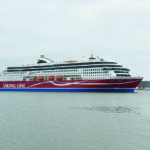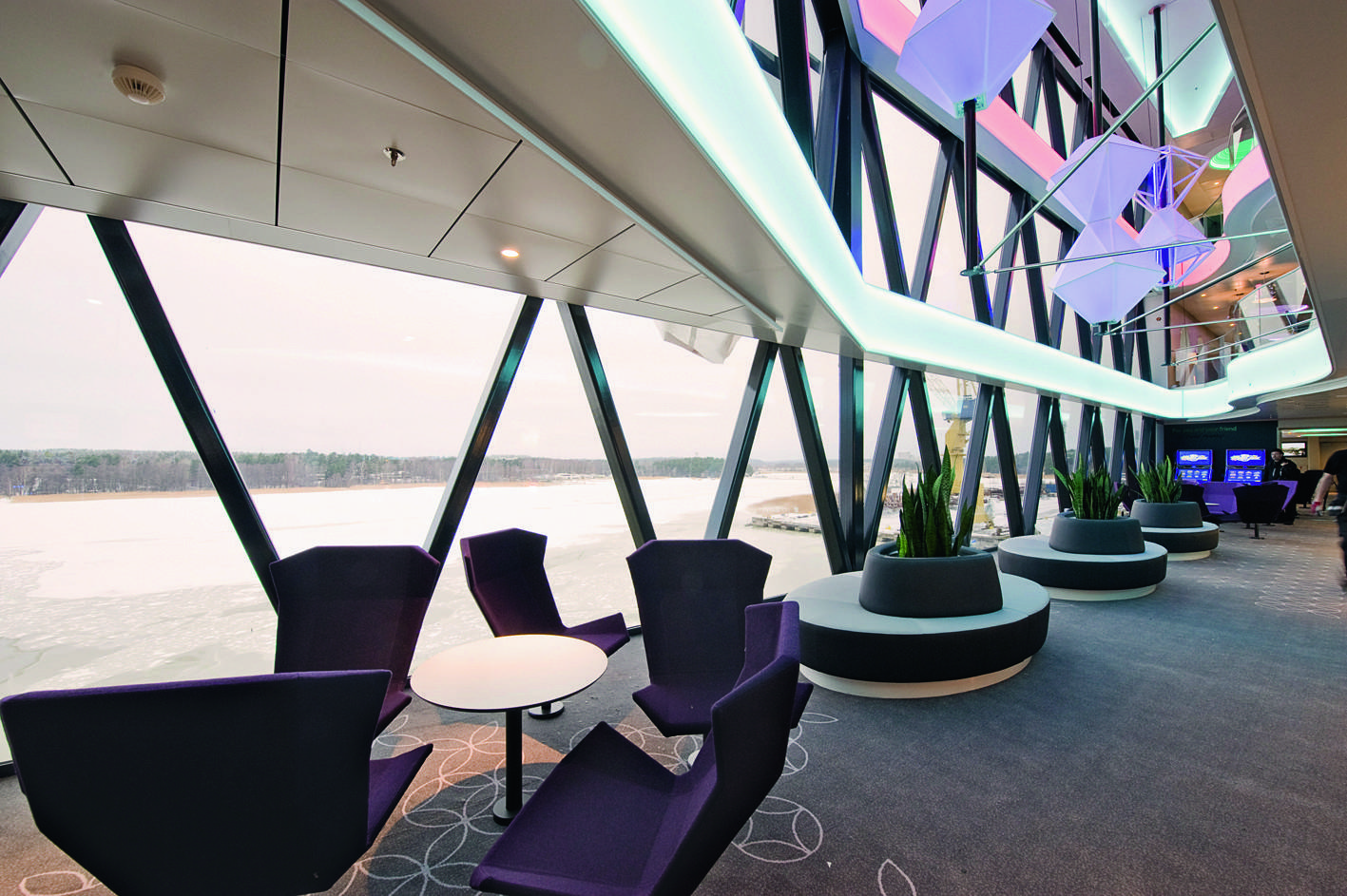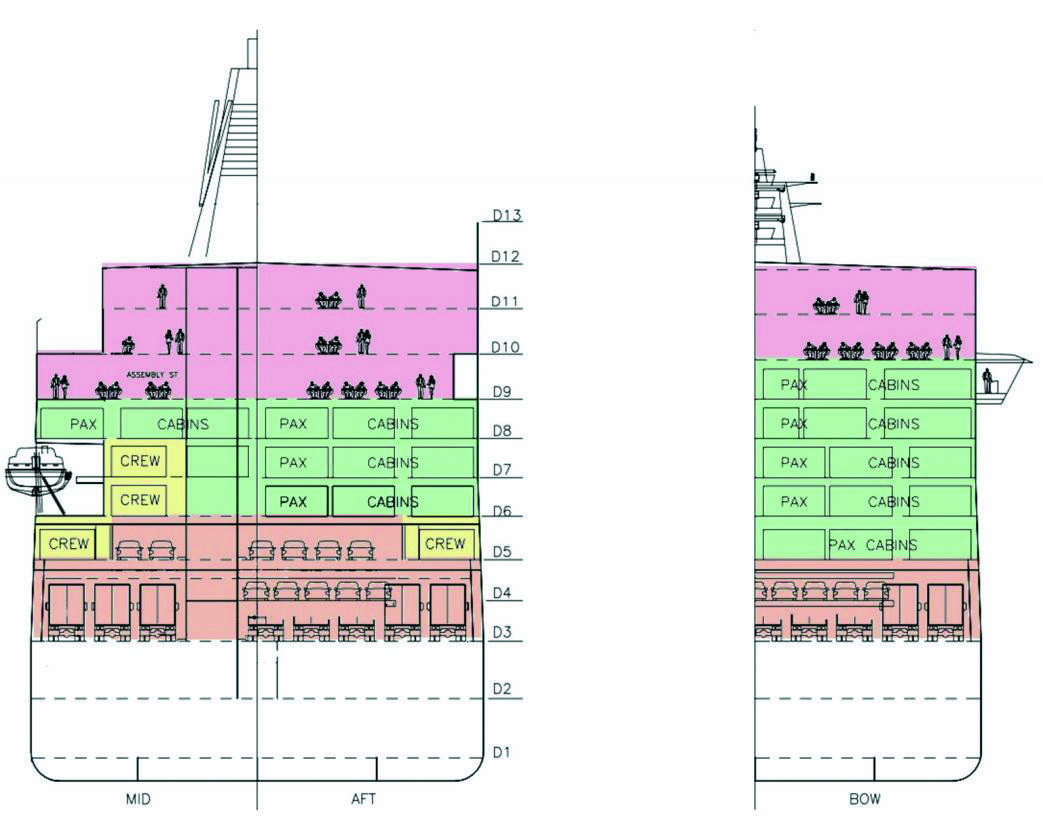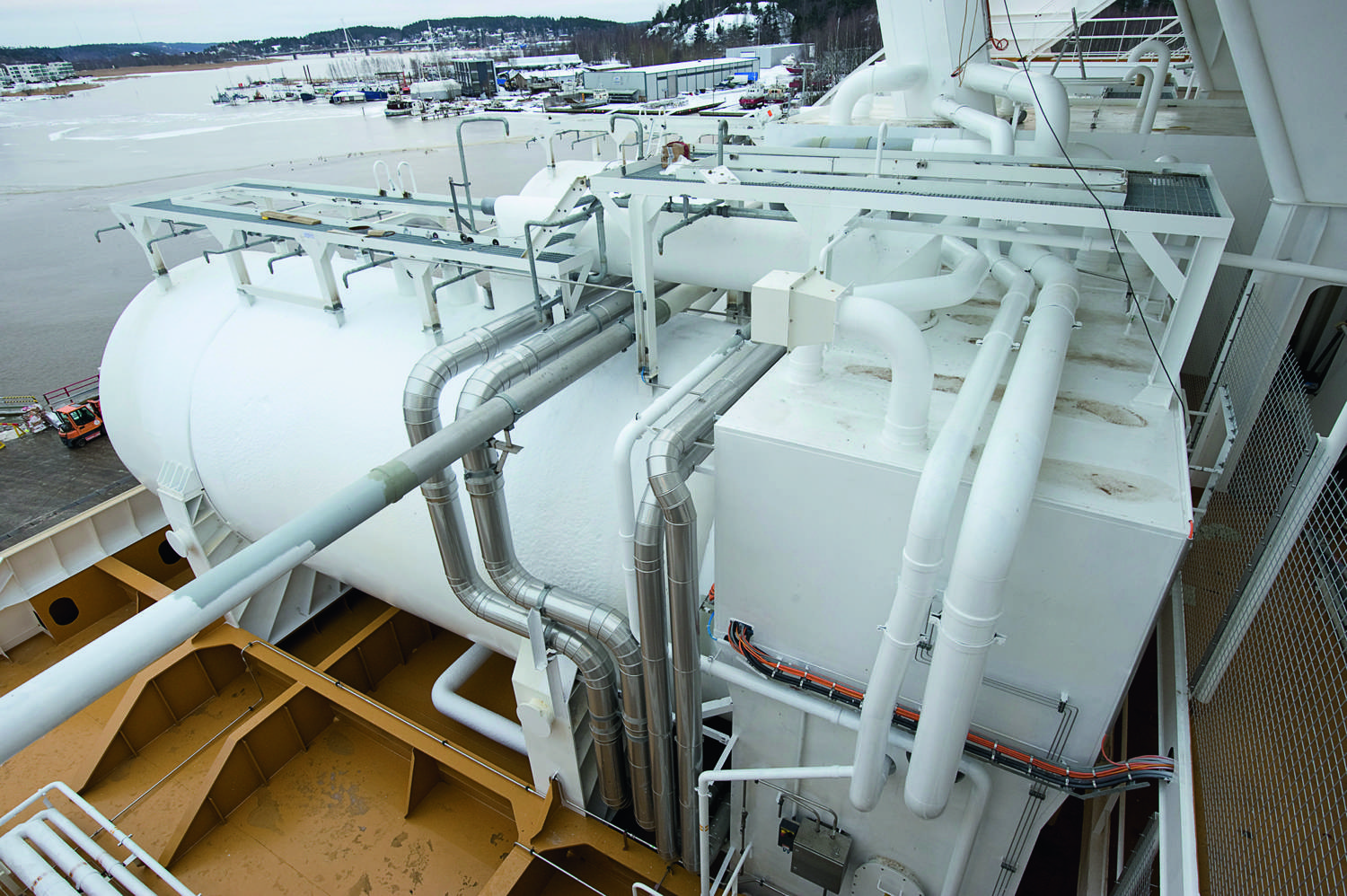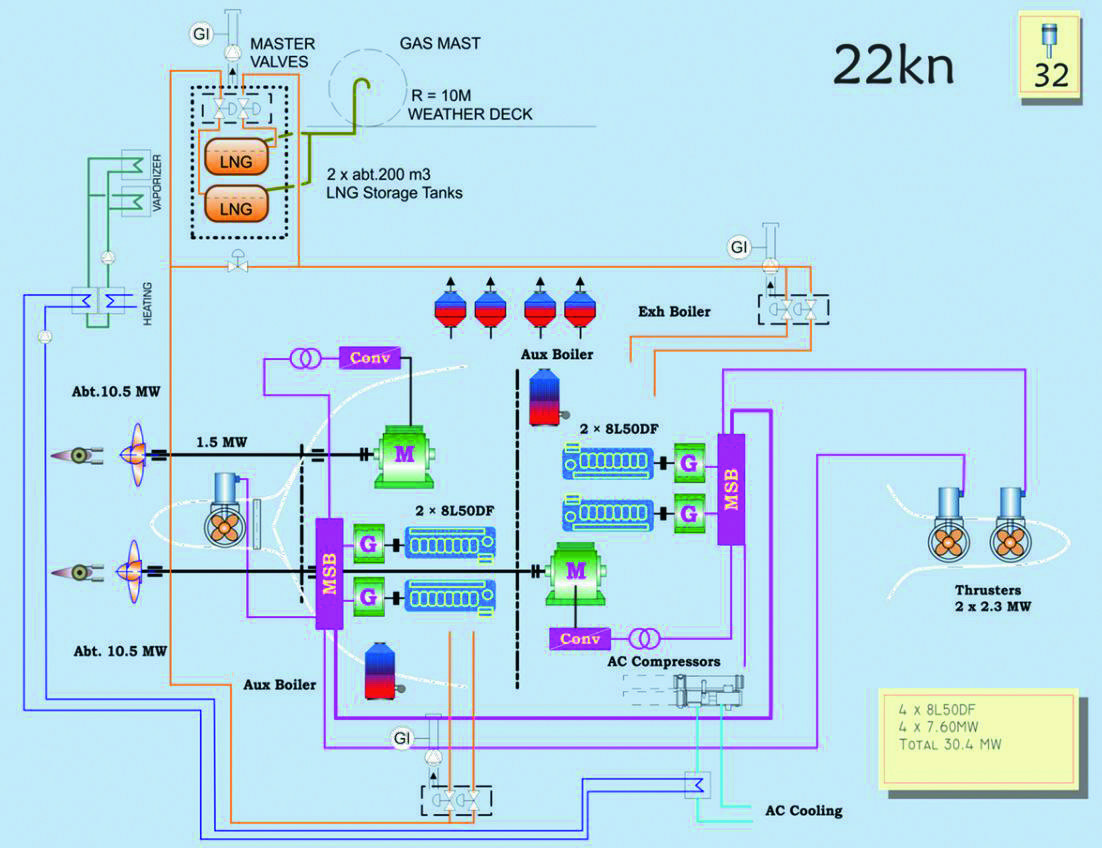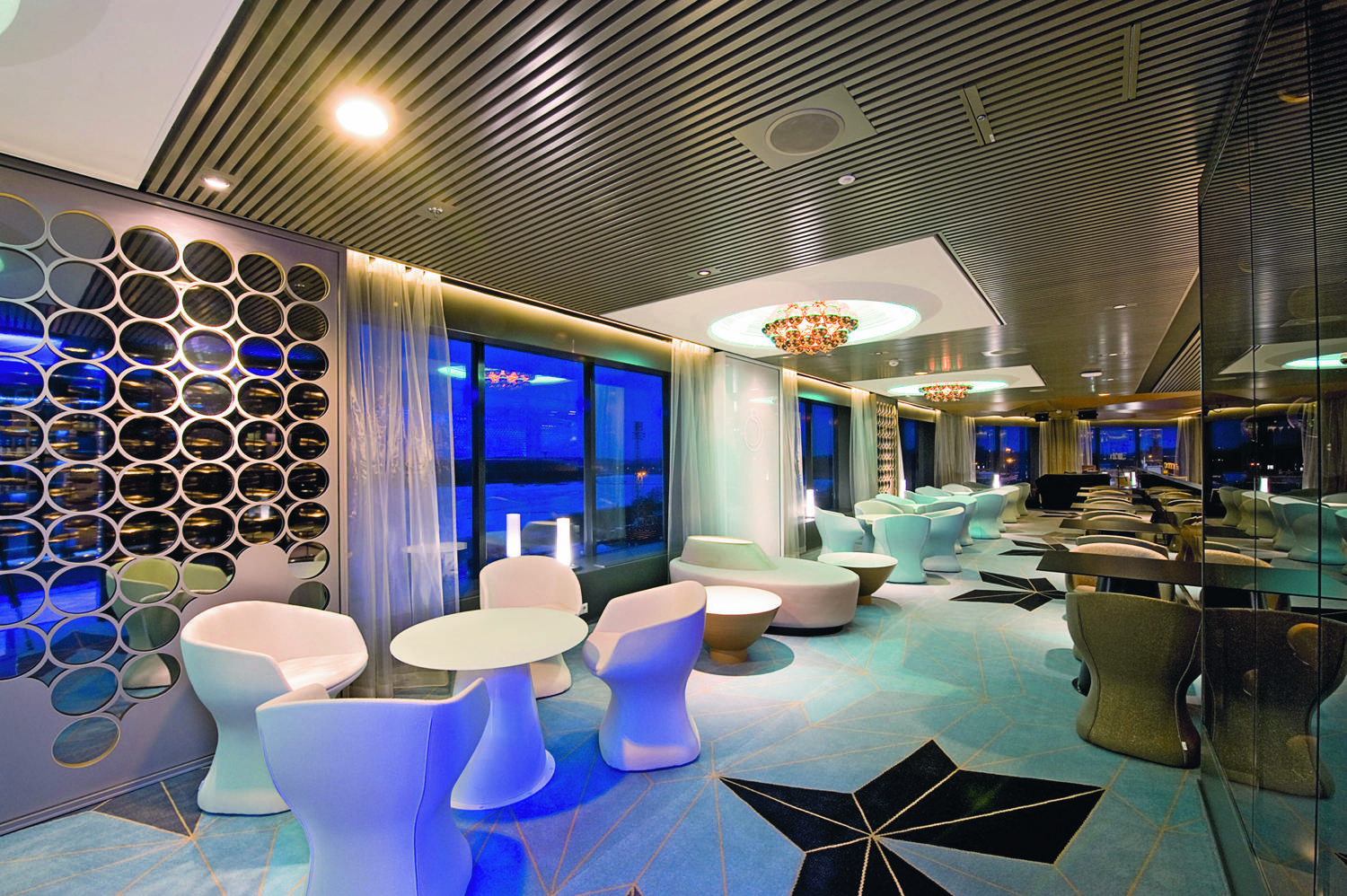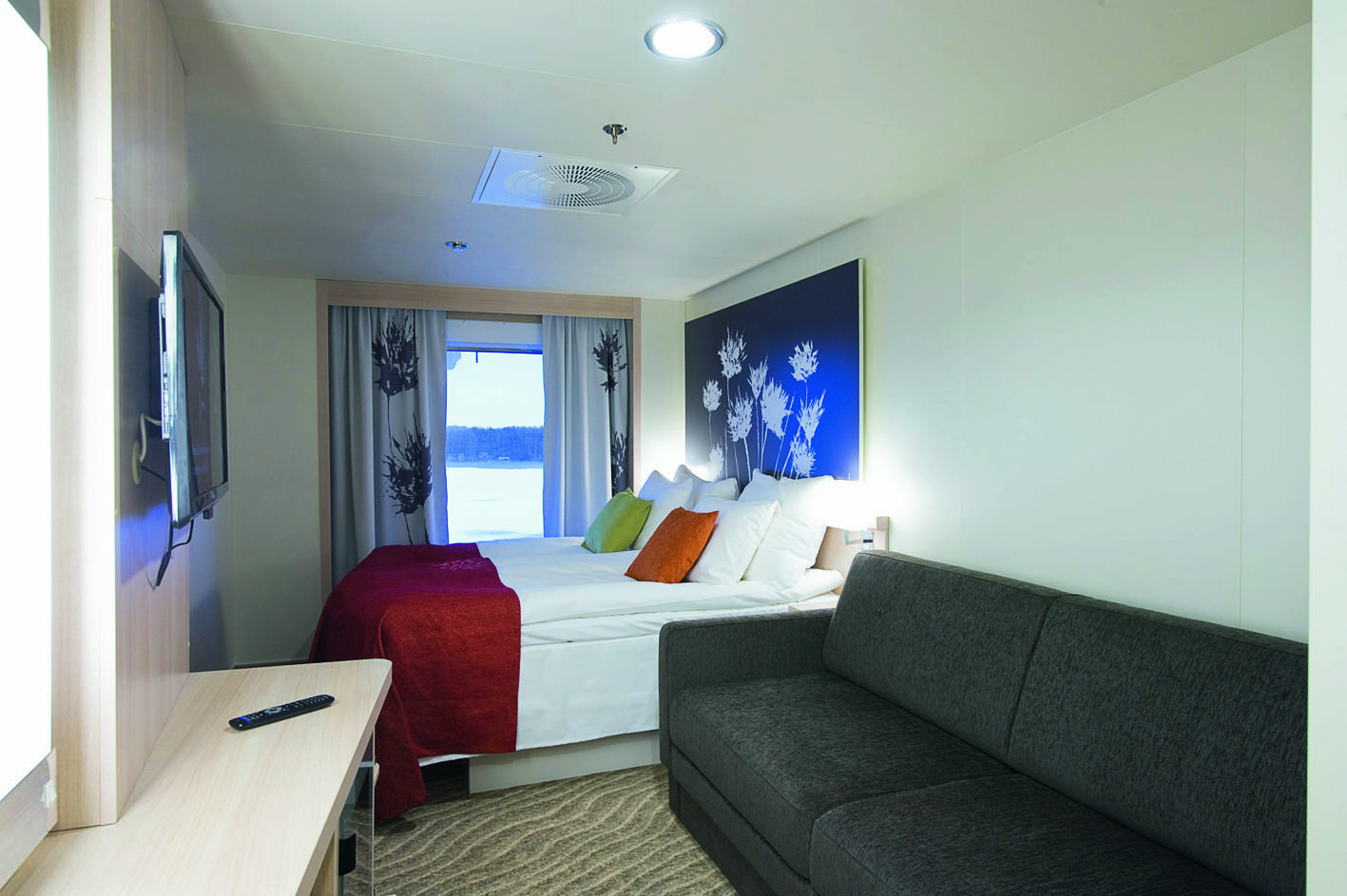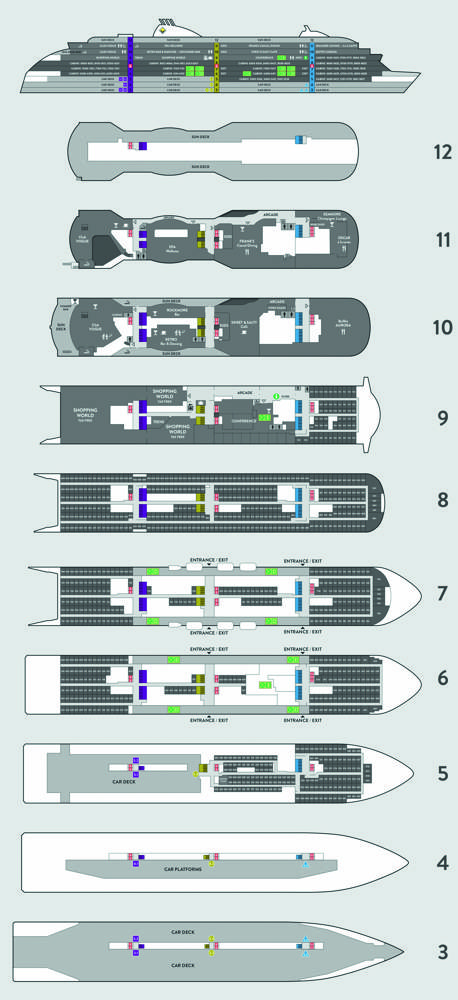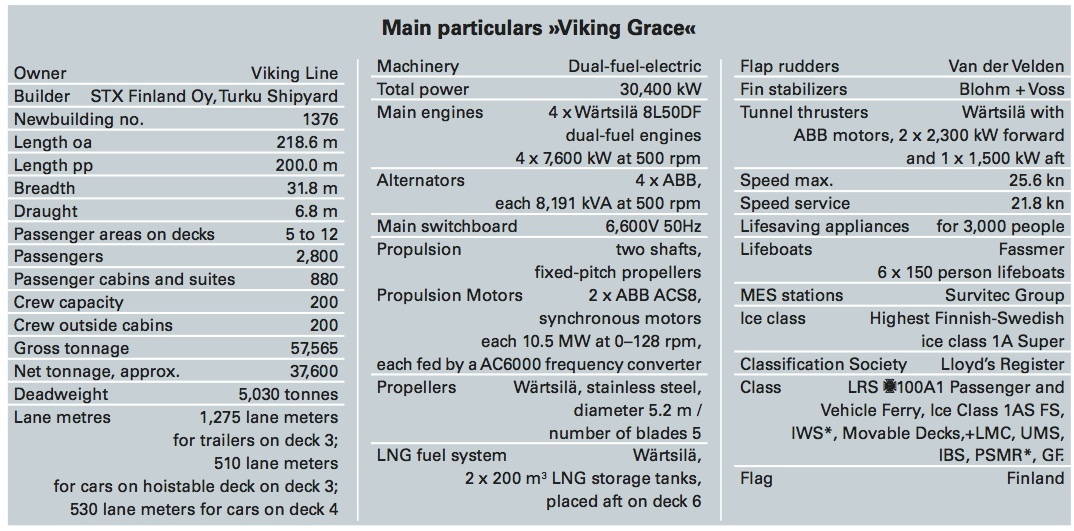Finnish ferry operator Viking Line started operating its new gas fuelled cruise ferry »Viking Grace« in January, on the route between Turku and Stochkholm, with calls at Åland Islands in between. »Viking Grace« is the first big passenger ferry which uses natural gas as fuel, stored on board as liquefied natural gas (LNG). Henrik Segercrantz describes the innovative vessel
The use of natural gas as fuel for ships, as an alternative to heavy fuel oil (HFO) or marine diesel[ds_preview] oil (MDO), is increasing. Until now, gas as fuel has been opted for some 110 LNG carriers, a number of offshore service vessels and smaller road ferries, primarily in Norway, and on some other cargo and offshore vessels. The market expectations are high for this fuel in coming years, which is now being made available in many ports in Europe and also elsewhere.
There are several reasons why Viking Line opted for gas as fuel for its newbuilding. Due to the increased amount of natural gas sources, the price of gas is low compared with the alternative HFO or MDO. With gas as fuel, »Viking Grace« does not have to worry about the upcoming strict sulphur emission regulations in the Emisson Controlled Area (ECA) of the Baltic Sea from year 2015, nor about the demanding Tier III NOx emission regulations due in 2016. When burning natural gas, the sulphur oxides (SOx) are almost entirely eliminated, as is most of the nitrogen oxides (NOx) and particle emissions. Vessels which today burn HFO, such as the seven other ferries in Viking Line’s fleet, will have to install scrubbers to extract the sulphur from the exhaust gas if they wish to continue using that fuel. The alternative, to switch to MDO, is not an option for vessels operating all the time within sulphur restricted ECA zones due to the big price difference, some 40 % to 70 % according to Viking Line’s estimations. The Port of Stockholm applies a system with lower harbour fees for lower SOx and NOx emissions, and the sea lane fees are also affected, which is another incentive for using gas as fuel.
The competition on the routes between Finland, Sweden and Estonia is tough. With »Viking Grace« Viking Line should be able to gain market shares both in passenger numbers and in wheel cargo volumes on this particular route.
Gas distribution and features
The market price of imported LNG in Europe has remained stable over a year’s time. The LNG hub market price today is some 25 € per MWh. The costs for local distribution of the fuel have to be added to this price. Although these costs – for transporting the LNG from the terminal at Nynäshamn, south of Stockholm, to the vessel in the Port of Stockholm – are high, the price difference still makes it competitive to that of HFO. Viking Line has made an agreement with Swedish AGA for the distribution of the gas for »Viking Grace«. The liquefied gas is transported by trucks to a gas storage facility at Loudden in the Port of Stockholm from where it is loaded onboard a specially converted bunker vessel, »Seagas« (a former road ferry, converted to AGA by Fiskerstrand, Norway). This vessel provides the fuel to »Viking Grace« when in Stockholm, typically every day except Sundays, some 70 t during the one hour time span while the vessel is in the port. When taking on LNG a hose is connected to the pipe coupling of the bunkering unit supplied by Wärtsilä in the bunker station placed in the aft. The hose coupling system is new, developed by Swedish company Mann Teknik. The entire gas tank system including the dual-fuel engines were supplied by Wärtsilä.
There are two 200 m3 LNG storage tanks on board »Viking Grace«, providing fuel for almost three days continuous operation. Additional diesel fuel is provided as back-up for some five days operation without bunkering. The LNG storage tanks are placed aft on deck 6, fitted with double-walls with vacuum and perlite as an insulating material in between, to maintain -162 °C required to keep the gas liquid. Dual stainless steel piping is used, with the space between arranged with ventilation and monitored for possible gas leaks. The increased pressure from the natural boil-off is used to transfer the gas from the storage tanks to the gas valve units in the main engine rooms, one unit for each engine and one for each of the two boilers, also using gas as fuel. The gas valve units adjust the pressure to the engine, with higher pressure for higher engine loads being some 6 bar. The entire gas system is designed for 10 bar. The gas can be kept liquid in the storage tanks for four to six weeks, if needed, by keeping the temperature and pressure low by spraying cold LNG from the lower part of the tank into the upper tank area thus condensing the gas back into liquid form.
Gas-electric machinery
In addition to using gas as fuel, »Viking Grace« is also equipped with electric machinery, another new feature in the fleet. According to the owner, a vessel fitted with generators and electric propulsion machinery today is more economical than using mechanical drives. Viking Line is able to reduce the number of crew on board by a few persons as gas-fuelled engines need less maintenance than conventional engines.
The additional cost for opting for gas instead of HFO as fuel raised the builiding costs by some 10 mill. €. The total investment was roughly 240 mill. €. In addition the Finnish state granted an environmental subsidy of 28 mill. € for the project. The order of »Viking Grace« was placed in December 2010. Construction began in September 2011 with keel laying taking place in March 2012. Launched in August 2012, two scheduled sea trials were conducted in November and December last year. An option for a sister ship was cancelled by the owner due to own financial reasons.
Main features
This is the first newbuilding for Mikael Backman, President and CEO of Viking Line since 2009, who before that worked as Vice President at Royal Caribbean International. He brought a lot of cruise ship know-how to the design of the newbuilding, reflecting the many new features seen on board the new ferry. Although many of the original ideas had to be left out due to cost implications, »Viking Grace« has a new layout and interior design.
The vessel was designed by the yard together with the owner based on the concept developed by the owner in-house. More 3D CAD design was used by the yard on this vessel than on any ship before. All 32,500 steel parts, about 22,000 components – such as valves, motors, interior and engine room components, the HVAC system etc. – were incorporated in the 3D model.
For the interior design Viking Line used the Finnish architectural firm dSign, which has not been involved in big tasks for ships before. The idea was to provide a good view overlooking the archipelago, a higher standard cruise ship with cabins placed forward, separated from the big number of restaurants and bars placed further aft.
Although her gross tonnage is 57,565 »Viking Grace« is just the fourth biggest ferry sailing in these waters, but she is the longest to achieve good fuel efficiency. The length overall is 218.6 m, breadth 31.8 m and draught 6.8 m. »Viking Grace« is able to reach a maximum speed of 25.6 kn and a service speed of 21.8 kn. The vessel accommodates 2,800 passengers and has a crew of slightly under 200 on board, all in all almost 400 people including a relief crew. Of the crew about 30 people are operating the vessel. »Viking Grace« has lifesaving appliances for 3,000 persons on board.
Layout
The two lowest decks under the bulkhead deck are for the machinery, control room, switchboard room, stores, food preparation, and some crew areas. Deck 3 is the trailer deck with 1,275 lane meters devided on eight lanes, when the hoistable car deck is not in use. Some 100 private cars can be stored on deck 5 above on 530 lane meters and on the hoistable platform on deck 3 which has 510 lane meters. The upper car deck is reached through a ramp or through two side doors.
Two 6 t provision lifts are arranged on deck 3 connecting with the preparation galley below. A cargo lift further aft is arranged for a full size trailer with container to serve ship and tax-free stores. These two areas are connected with a wide service corridor under deck 3. Deck 5 has passenger cabins in the forward fire zone with inside passenger cabins for drivers or groups, and behind this area there are crew cabins with view.
The LNG storage tanks are aft on deck 6, with passenger cabins arranged both in the front part and aft and midships. This deck also facilitates crew cabins, a crew day room, the drivers’ and crew mess arranged from midships forward. Deck 7 has a similar cabin arrangement. This deck is also embarkation deck to the life boats, on this ship placed ready in embarkation position. Decks 6 and 7 are fitted with passenger entrance and exits midships and behind the forward fire zone. Deck 8 is a passenger cabin deck.
The public areas are arranged on decks 9,10 and 11. The vessel basically has four fire zones. Three main staircases with adjacent elevators are arranged aft, midships and forward. Restaurants serving food are arranged on decks 10 and 11 from midships forward, and bars serving drinks are placed from midships aft. Compared with earlier Viking Line vessels, »Viking Grace« is arranged with passenger entrance directly to the cabin decks on two decks forward and aft. The twelve public spaces – these are the promenade, entrée, restaurants, bars and the play rooms – have a non-traditional interior design with lots of special new features. Eight restaurants and food outlets seat altogether 1,200 people, with children’s playrooms arranged nearby on both decks 10 and 11, a smart solution. There are several dance bars offering different types of music. The night club aft, two decks high, seats more than 1,000 people.
The very big duty-free shop on board is 1,600 m2 in size and placed on deck 9. It is arranged aft in three sections, one also for teens. The conference area stretches from midships forward to where the ship’s reception is placed, which thus also serves conference guests. The conference area has flexibly adjustable spaces and an auditorium seating 220 people. Forward on deck 9 the bigger size cabins are located in the forward fire zone. The ship’s wheelhouse is placed on this deck with accommodation for master and chief engineer behind.
A wellness and spa area is placed on deck 11. Deck 12 is the outside sun deck, with technical ventilation spaces arranged in the middle. There are 880 passenger cabins on board plus four suites and 200 crew cabins with outside view. The cabins are built by STX Cabins. All cabins and suites are of exceptionally high standard not common on a ferry.
Fuel efficiency
Viking Line provides an interesting comparison of »Viking Grace« with another vessel in the fleet, »Isabella«, which she replaced on the Turku–Stockholm route. This vessel has a gross tonnage of 35,154 GT, an installed machinery power of 31,180 kW and a propulsion power of 23,000 kW allowing a speed of 21.5 kn.
»Viking Grace« has a much bigger gross tonnage, an installed power of 30,400 kW, a propulsion power of 21,000 kW and a speed of 23 kn. The annual fuel consumption of »Isabella« is 24,300 t HFO, i.e. 691 kg/GT, compared with 20,000 t LNG, 350 kg/GT of »Viking Grace«, which also has a very low Energy Efficiency Design Index.
In order to achieve the best possible fuel efficiency, STX Turku Shipyard did some 65 in-house computational fluid dynamics simulations optimising the shape of the hull and appendages. The final model tests confirming the calculations were done by the Maritime Research Institute Netherlands. The vessel operates at two distinct speeds, around 15 kn and around 21 kn. To reduce wave forming at lower speeds the bulb was re-shaped, which again was compensated by adding a 4 m long duck-tail to the hull. The hull has practically no parallel mid section, all this adding up to a very efficient hull form.
Technical features
Lloyd’s Register (LR) handled the classification of »Viking Grace«, based on their vast know-how in LNG vessel technology. »Viking Grace« was built according to the provisional natural gas as fuel rules from January 2007. She is the first vessel in the fleet which fulfils IMO SOLAS »Safe Return to Port« requirement, requiring many design considerations in order to fulfil the redundancy needed to take the ship to port regardless of a system failure within any of the fire zones. On »Viking Grace« the engines are placed in two separate engine rooms, two engines in each, arranged with a longer shaft line to the electrical propulsion motor of the forward engine room. The aft engine room is identical but mirrored, with the engines on the starboard side and the shorter shaft and propulsion motor on the port side.
The machinery of »Viking Grace« consists of four 7,600 kW Wärtsilä 8L50DF dual-fuel engines each connected to a ABB generator producing 8,191 kVA at 500 rpm to the main switchboard of the vessel. The main switchboard has a voltage of 6,600 V at 50 Hz. The two ABB ACS8 synchronous electric propulsion motors each produce a power of 10.5 MW from 0 to 128 rpm. Each motor is fed by a AC6000 frequency converter. There are two shafts and two fixed-pitch stainless steel five-bladed propellers also supplied by Wärtsilä. There are two 2,300 kW bow tunnel thrusters and one 1,500 kW tunnel thruster aft. The vessel is fitted with flap rudders, fin stabilizers and an anti-heeling system. Saacke delivered the two auxiliary 7 t/h boilers, fuelled by either gas or fuel oil, and also the four 2.05 t/h exhaust gas economizers on board. Viking Line preferred in-line engines as they are easier to maintain. The vessel can reach 15 kn with only two generators powering one propulsion motor and can operate continuously with three engines running allowing the fourth to be serviced.
SAM Electronics supplied their Nacos Platinum integrated navigation control system and Valmarine, also part of L-3, their Valmatic Platinum integrated automation system. Cockpit-type navigation console seating is arranged for three. The safety center is in the aft end of the bridge. The integrated automation system controls all machinery including extended facilities for vessel power management as well as those for emergency shut-down. A dynamic positioning system is supplied by Navi. »Viking Grace« uses ABB’s EMMA energy management system.
The loading computer and the electronic logbooks were supplied by Napa. The loading computer produces accurate calculation results as it utilizes the real 3D model of the ship. Napa Logbook combines common data storage, automation interfaces, reminders, guidelines and check lists enabling improved reporting.
The AC automation system is supplied by Koja, which supplies the HVAC systems for the accommodation and cargo areas. The LNG system provides cooling water for the AC system, when cooling is required in summertime, reducing the need for using the separate chillers. The shipyard designed and built most of the air-condition rooms as separate modules preconstructed ashore. The ventilation system of the machinery spaces was supplied by Novenco.
Environment
The exhaust gases produced by burning gas as fuel are cleaner than those produced by using HFO. The efficient hull and propulsion system reduces the fuel consumption and the greenhouse gases emitted. The potential drawback of methane slip, natural gas let out into the atmosphere, was taken very seriously by Viking Line when looking at gas engines as an option.
Methane (CH4) as a greenhouse gas is some 25 times more damaging than CO2. Through calculations of all different operation modes and engine loads, the resulting CO2 equivalent was calculated and compared with that of using heavy fuel oil with 1 % sulphur content. The gas engine uses some 1.5 % MDO as pilot fuel. As more power per cylinder can be achieved by using HFO instead of gas the comparison was made with four 7L46F engines using HFO and four 8L46F dual-fuel engines using gas. The results are shown in Table 1, which concludes that the dual-fuel engines emit 25 % less greenhouse gases than an equivalent HFO fuelled machinery. NOx is reduced by 88 %, SOx by almost 100 % and particles by some 84 %. The boilers were not included in the calculations. Including these in the calculations would benefit gas machinery further.
All onboard ship waste is taken ashore, having been sorted and packed. All grey and black waste water is taken ashore for waste treatment in land-based waste treatment stations.
Other systems and technologies
There are 14 elevators on »Viking Grace«, developed and supplied by Kone, to serve the 1,000 passengers and personnel on board. Kone’s Regenerative Drive solution is applied as standard for all the elevators, for the first time on a maritime installation. The motor of the elevator participates in the breaking work and it doubles as an electric generator. The extra energy captured in this way is returned to the electric grid saving up to 30 % of the net energy consumed by the elevators.
There are two big 50 m3 insulated accumulator tanks on board, which conserve the heat energy from the exhaust gas. When no heat energy from the engines is available during port time, heat is taken from these tanks. Through this Viking Line avoids using the boilers.
As IMO’s SOLAS regulations do not allow for only marine evaquation systems (MES) stations to be used on this type of vessel and route, lifeboats, supplied by Fassmer, provide the main means of emergency floatation for the passengers. There are, however, four RFD MES stations on board supplied by Survitec Group.
Autronica supplied the fire alarm system and Marioff the hi-fog sprinkler system. TTS Marine, Sweden, delivered and installed the shell doors, ramps, and hoistable decks and the 40 t and 6 t cargo lifts. Loipart supplied the cold rooms onboard. Almaco supplied the food handling areas.
LED lighting is used extensively on board including in almost all inside spaces where motion detectors control the lighting. The LED suppliers included Finnish Hella. Eaton supplied the UPS systems. SBA Interior Ltd supplied all some 2,500 pullman beds and corridor and wall panels. FinnBrass supplied the railings and Parmarine the fire doors. Alcatel supplied the onboard telephone system.
Engaged in the work on designing and building »Viking Grace« were companies like Elomatic, in charge of much of the detail design, as well as Sance, Loipart, Naval Interior Team, Shipbuilding Completion, and Orsap. There are some 1,800 own employees currently working at STX Turku Shipyard. Counting suppliers, in all 2,700 people work at the yard.
Henrik Segercrantz





